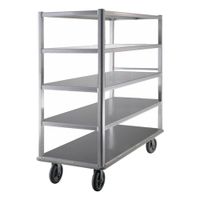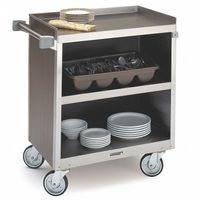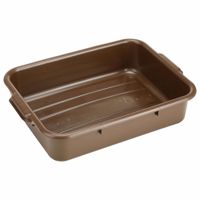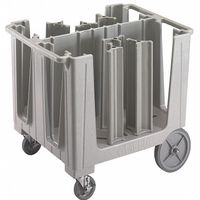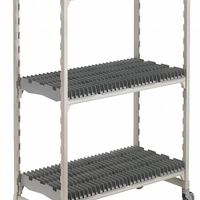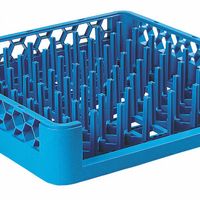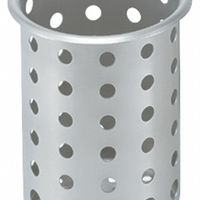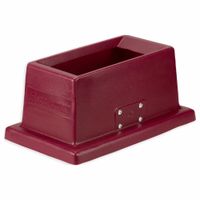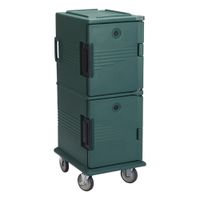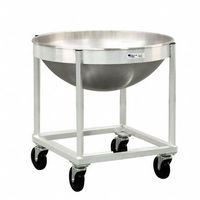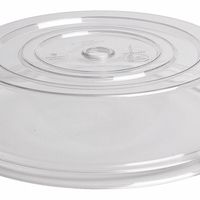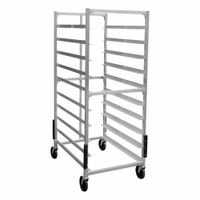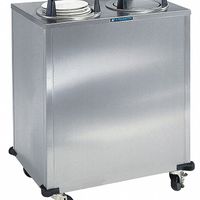Call +(254) 703 030 000 / 751 483 999 / 721 704 777
- Home
- Furnishings Appliances Hospitality
- Tableware Smallwares Food Service Storage Transport
- Food Service Storage Transport
- Meal Service Bussing Transport
.....Read More
Frequently Asked Questions
What are the different types of meal service carts used in food service?
1. **Tray Service Carts**: Used for delivering individual meal trays, often in hospitals or airlines. They are designed to keep food warm and organized.
2. **Beverage Carts**: Equipped with compartments for drinks, ice, and glassware. Commonly used in hotels, conferences, and on airplanes.
3. **Dessert Carts**: Display and serve desserts. They often have glass covers to showcase the items and maintain freshness.
4. **Buffet Carts**: Portable units for buffet-style service, featuring hot and cold compartments to maintain food temperature.
5. **Salad Carts**: Designed for salad preparation and service, with compartments for ingredients and dressings.
6. **Dim Sum Carts**: Used in Chinese restaurants to serve dim sum. They are often heated to keep the food warm.
7. **Gueridon Service Carts**: Used in fine dining for tableside service, including flambéing or carving dishes.
8. **Room Service Carts**: Designed for hotel room service, often with foldable trays and compartments for condiments and utensils.
9. **Banquet Carts**: Large, insulated carts used to transport and serve meals at events, keeping food at the desired temperature.
10. **Pastry Carts**: Used to display and serve pastries, often with glass covers for visibility and freshness.
11. **Cheese Carts**: Used in fine dining to present and serve a selection of cheeses tableside.
12. **Breakfast Carts**: Designed for breakfast service, often featuring compartments for coffee, pastries, and condiments.
13. **Hot Food Carts**: Insulated and heated to keep food warm during transport and service.
14. **Cold Food Carts**: Equipped with refrigeration to keep food items chilled during service.
15. **Utility Carts**: Versatile carts used for various purposes, including transporting dishes, utensils, and other service items.
How do insulated food carriers maintain food temperature?
Insulated food carriers maintain food temperature through a combination of materials and design features that minimize heat transfer. These carriers typically use layers of insulating materials such as foam, fiberglass, or vacuum-sealed panels, which reduce the conduction of heat. The insulation creates a barrier that slows down the exchange of heat between the interior of the carrier and the external environment.
The design of the carrier also plays a crucial role. Many carriers are airtight, which limits heat loss through convection by preventing the movement of air in and out of the container. Some carriers include tight-sealing lids or doors with gaskets to enhance this effect. Additionally, reflective materials may be used on the interior surfaces to reduce heat loss through radiation by reflecting thermal energy back towards the food.
For hot foods, the carrier retains heat by trapping the warm air and reflecting the heat back to the food. For cold foods, the insulation prevents external heat from entering, maintaining a cooler internal temperature. Some carriers also incorporate phase change materials (PCMs) that absorb or release heat as they change states, further stabilizing the temperature.
The effectiveness of an insulated food carrier is influenced by its construction quality, the thickness and type of insulation, and the initial temperature of the food. Pre-heating or pre-cooling the carrier before use can enhance its performance. Overall, the combination of these elements allows insulated food carriers to maintain food at safe and desirable temperatures for extended periods, ensuring food safety and quality during transport.
What materials are commonly used for food transport equipment?
Common materials used for food transport equipment include:
1. **Stainless Steel**: Known for its durability, corrosion resistance, and ease of cleaning, stainless steel is widely used in food transport equipment such as carts, containers, and trolleys.
2. **Plastic**: High-density polyethylene (HDPE) and polypropylene are popular for their lightweight, non-corrosive, and cost-effective properties. They are used in crates, bins, and insulated containers.
3. **Aluminum**: Lightweight and resistant to corrosion, aluminum is often used in the construction of food transport carts and trays.
4. **Insulated Foam**: Expanded polystyrene (EPS) and polyurethane foam are used for their excellent thermal insulation properties, keeping food at the desired temperature during transport.
5. **Glass**: Used in some specialized containers, glass is non-reactive and maintains food quality, though it is heavier and more fragile.
6. **Composite Materials**: Combining different materials to enhance strength and insulation, composites are used in advanced food transport solutions.
7. **Rubber**: Used for gaskets and seals in containers to ensure airtight and leak-proof transport.
8. **Nylon and Polyester**: These materials are used in the construction of soft-sided insulated bags and carriers due to their durability and flexibility.
9. **Silicone**: Used for seals and flexible containers, silicone is heat-resistant and non-reactive.
10. **Wood**: Occasionally used for crates and pallets, though less common due to hygiene concerns.
These materials are selected based on their ability to maintain food safety, hygiene, and temperature control during transport.
How do you clean and maintain bussing transport carts?
To clean and maintain bussing transport carts, follow these steps:
1. **Preparation**: Gather cleaning supplies such as a mild detergent, disinfectant, soft cloths, sponges, brushes, and a bucket of warm water. Wear gloves for protection.
2. **Empty the Cart**: Remove all items from the cart, including trays, dishes, and any debris. Check for any removable parts and detach them for separate cleaning.
3. **Initial Rinse**: Use a hose or a bucket of water to rinse off loose dirt and debris from the cart. This helps in removing surface grime.
4. **Cleaning**: Apply a mild detergent mixed with warm water to the cart using a sponge or cloth. Scrub all surfaces, including shelves, handles, and wheels. Use a brush for hard-to-reach areas and stubborn stains.
5. **Disinfection**: After cleaning, apply a disinfectant to all surfaces to kill bacteria and germs. Ensure the disinfectant is food-safe if the cart is used in food service areas.
6. **Rinse Thoroughly**: Rinse the cart again with clean water to remove any soap or disinfectant residue. Ensure all cleaning agents are completely washed off.
7. **Drying**: Wipe the cart with a dry cloth or allow it to air dry completely. Ensure no moisture is left, as it can lead to rust or mold.
8. **Inspect and Maintain**: Check for any damage or wear, such as loose wheels or broken parts. Tighten screws and replace any damaged components. Lubricate moving parts like wheels to ensure smooth operation.
9. **Reassemble and Store**: Reattach any removable parts and store the cart in a clean, dry area. Ensure it is ready for the next use.
Regular cleaning and maintenance extend the lifespan of bussing transport carts and ensure hygiene and efficiency in operations.
What are the benefits of using dispensers and dispenser carts in food service?
Dispensers and dispenser carts offer numerous benefits in food service, enhancing efficiency, hygiene, and customer satisfaction.
1. **Efficiency and Speed**: Dispensers streamline the serving process by allowing quick and easy access to condiments, beverages, or utensils, reducing wait times and improving service speed. Dispenser carts, being mobile, facilitate the swift movement of food and supplies across different service areas, optimizing workflow.
2. **Portion Control**: Dispensers ensure consistent portion sizes, minimizing waste and controlling costs. This is particularly beneficial for high-volume items like sauces or dressings, where overuse can significantly impact expenses.
3. **Hygiene and Safety**: By minimizing direct contact with food items, dispensers reduce the risk of contamination, promoting a safer dining environment. This is crucial in maintaining health standards and preventing foodborne illnesses.
4. **Space Optimization**: Dispensers and carts help organize and declutter service areas, making efficient use of available space. This organization not only enhances the aesthetic appeal but also improves the functionality of the service area.
5. **Versatility and Customization**: Dispenser carts can be customized to fit specific needs, whether for beverages, snacks, or full meals. This adaptability allows food service providers to cater to diverse customer preferences and operational requirements.
6. **Cost-Effectiveness**: By reducing waste and improving efficiency, dispensers and carts contribute to cost savings. They also lower labor costs by simplifying tasks and reducing the need for additional staff.
7. **Enhanced Customer Experience**: Quick service, cleanliness, and consistent quality contribute to a positive dining experience, encouraging repeat business and customer loyalty.
Overall, dispensers and dispenser carts are valuable tools in food service, offering practical solutions to common operational challenges while enhancing the overall dining experience.
How do bus tubs and dishwasher racks improve efficiency in cleaning?
Bus tubs and dishwasher racks significantly enhance cleaning efficiency in commercial and residential settings by streamlining the process of collecting, organizing, and washing dishes.
Bus tubs are used to gather and transport dirty dishes, utensils, and glassware from dining areas to the kitchen. This reduces the number of trips needed, saving time and labor. By consolidating items in one place, bus tubs minimize clutter and prevent breakage, ensuring a smoother workflow. They also help in pre-sorting items, which speeds up the subsequent washing process.
Dishwasher racks are designed to hold dishes, glasses, and utensils securely during the washing cycle. Their structured layout maximizes space, allowing more items to be washed simultaneously, which increases throughput. The design of these racks ensures that water and detergent reach all surfaces of the items, leading to more effective cleaning. Specialized racks for different items, such as glass racks or utensil holders, further optimize the washing process by preventing damage and ensuring thorough cleaning.
Together, bus tubs and dishwasher racks reduce manual handling, lower the risk of breakage, and enhance the overall speed and effectiveness of the cleaning process, leading to improved operational efficiency.
What safety features should be considered when selecting food service transport equipment?
When selecting food service transport equipment, consider the following safety features:
1. **Temperature Control**: Ensure the equipment can maintain safe temperatures for hot and cold foods to prevent bacterial growth. Look for units with reliable insulation and temperature monitoring systems.
2. **Durability and Stability**: Choose equipment made from robust materials that can withstand frequent use and transport. Stability features, such as non-slip surfaces and secure locking mechanisms, prevent spills and accidents.
3. **Ease of Cleaning**: Select equipment with smooth, non-porous surfaces that are easy to clean and sanitize, reducing the risk of cross-contamination.
4. **Secure Latching Systems**: Ensure that doors and lids have secure latching systems to prevent accidental openings during transport.
5. **Mobility and Maneuverability**: Opt for equipment with sturdy wheels and ergonomic handles for easy transport. Swivel casters and brakes enhance control and safety.
6. **Ergonomic Design**: Equipment should be designed to minimize strain and injury risk for users, with features like adjustable heights and easy-to-grip handles.
7. **Load Capacity**: Ensure the equipment can safely handle the intended load without risk of tipping or structural failure.
8. **Ventilation**: Proper ventilation prevents moisture buildup and maintains food quality, especially for hot foods.
9. **Compliance with Standards**: Verify that the equipment meets relevant health and safety standards, such as NSF certification, ensuring it is safe for food contact.
10. **Fire Safety**: For heated units, ensure they have safety features like automatic shut-off and overheat protection.
11. **Visibility and Labeling**: Clear labeling and visibility features help in identifying contents quickly, reducing handling errors.
12. **Shock Absorption**: Features that absorb shocks during transport protect both the equipment and the food from damage.
